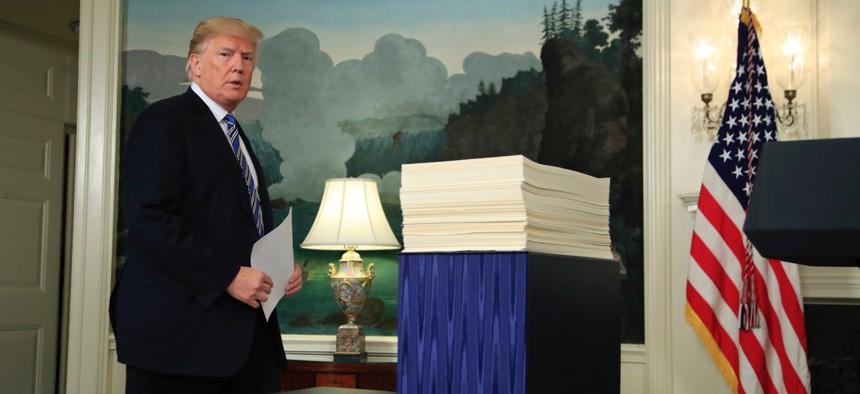
President Donald Trump arrives in the Diplomatic Room of the White House in Washington on March 23 to speak about the $1.3 trillion spending bill which he signed earlier in the day. AP Photo/Manuel Balce Ceneta
Trump Backs Off Budget Veto in Odd White House Event Laden with Misstatements
The mischaracterization of the 2018 defense budget as the biggest ever was just the start.
Watching President Trump stand at a podium reading a laundry list of weapons that the Pentagon will buy with its just-signed $654.6 billion check was eerily reminiscent of a Middle East arms show.
As each day closes at events like the biannual IDEX conference in Abu Dhabi, for example, a general will come to the press center and read a list of newly inked deals for tanks, ships, and warplanes. Trump, on Friday, took similar pains to note various big-ticket weapons in the $1.3 trillion government spending bill for fiscal 2018 to convince the American public of the merits of signing it.
Along the way, the commander in chief made several incorrect statements. For example, he said the money would “procure 34 Navy ships.” But the Senate Appropriations Committee summary of the bill says, “In total, the agreement funds the construction of 14 new ships.” He also said the bill included “$2.9 billion for 15 KC-46 tanker aircraft.” In fact, the money allows the Air Force to buy 18 aerial refueling tankers.
Then there was the inaccurate characterization of the size of the overall Defense Department’s budget. Standing beside Trump, Defense Secretary Jim Mattis said “we received the largest military budget in history.” In real terms — that is, after adjusting for inflation — the Pentagon’s budget was much bigger between 2007 and 2011 under President’s George W. Bush and Barack Obama. Their budgets came at the height of the Iraq War when hundreds of thousands U.S. forces were deployed in combat.
Then there was Trump’s unusual statements about Democratic lawmakers’ “opposition to the military” and accusing them, in so many words, of not supporting the troops. In fact, the 2018 National Defense Authorization Act, or NDAA, passed in the House by a vote of 356-70 (63 Democrats voted against it). In 2017, the NDAA passed 375-34 (30 Dems voting against). A similar pattern has held going back a half-century. Indeed, in February, Rep. Mac Thornberry, R-Texas, chairman of the House Armed Services Committee said, “It really has been bipartisan…the difficulty is what happens with the other stuff in the budget and people trying to put other issues into the mix.”
The question becomes, why all of this detailed military talk by the president? The talking points he read from a prepared statement at the White House on Friday matched, nearly word-for-word, ones issued by the Republicans on House Armed Services Committee, and were repeated by House Speaker Paul Ryan, R-Wisc., before Thursday’s vote on the bill.
Perhaps Trump wanted to look strong and project power. Pentagon leaders have issued warnings to Congress about poor readiness across the military going back more than five years — again, into Obama’s administration. Mattis and others have clamped down on public talk about anything related to poor readiness, because they believe China and Russia are exploiting America’s weaknesses or perceived weaknesses. Mattis has said he privately has made sure Congress knows about the shortfalls he perceives, though senior enlisted officers have challenged the “readiness crisis” portrayal of the armed forces.
Or perhaps the U.S. president was taking a page from his guest this week, Saudi Arabia’s Crown Prince Mohammad bin Salman, who met with Trump at the White House on Tuesday.
Or maybe Trump wanted to look tough to China, after slapping tariffs on imports earlier this week. When he announced those tariffs, the president summoned leaders of some of America’s largest defense firms at his side: Lockheed Martin’s Marillyn Hewson, Raytheon’s Tom Kennedy; Leidos’ Roger Krone and General Atomics’ David Alexander.
The $1.3 trillion spending bill represents a big win for defense hawks, who had unsuccessfully lobbied to remove federal spending caps for more than six years. House Speaker Paul Ryan, R-Wisc., who rarely delved into the defense debate, has taken a more active role in recent months, talking about the military more often as lawmakers has budget negotiations.
The military now has money to spend to improve readiness and buy the new equipment commanders say they desperately need. But the next budget fight is already under way as the bill Trump signed Friday expires at the end of September.
“I will never sign another bill like this again,” Trump said of the bill he signed on Friday.
We’ll see. The 2019 budget bill is due on his desk by Sept 30.
